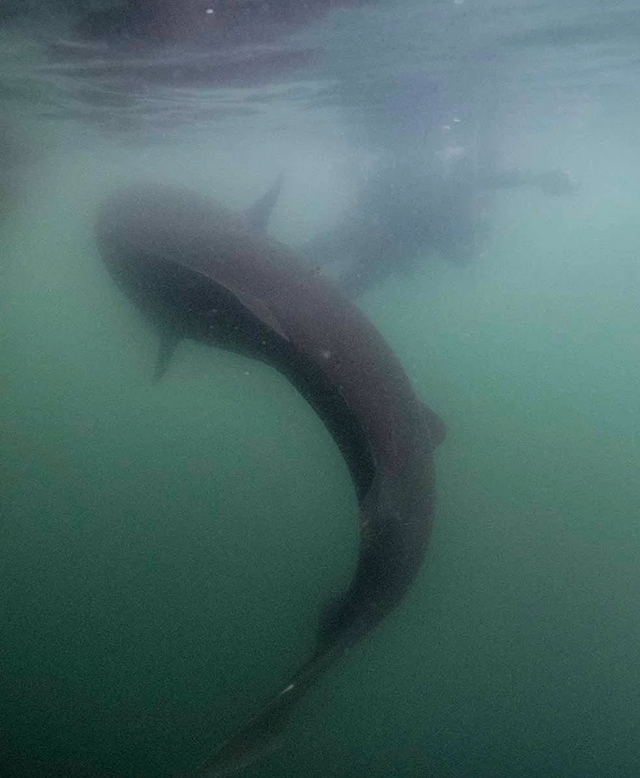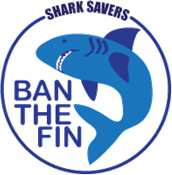
![]()
Home > Shark Diving > Shark Dive Tours
Sleeper Shark Diving Trip in Alaska
with Boone Hodgin

Worlds first scuba diving images of a Sleeper Shark!
The most interesting fact about this family of sharks is that it has recently been discovered that it is the oldest living animal on Earth with a backbone! Using an unusual dating technique, an international team of biologists and physicists estimated the age of 28 dead female sharks based on tissue in their eyes. Eight of the sharks were probably 200 years or older and two probably date back more than three centuries, with the oldest being over 400 years of age. Until now, that record holder was a bowhead whale that hit 211 years old.
Sleeper Shark diving trips are not combined with other trips and are considered stand alone trips due to the amount of time and equipment needed to locate and bring these sharks to the surface. These are custom trips geared towards film crews and diving groups that are willing to spend a dedicated amount of time towards this one species.
These sharks are a deep water animal that come into shallower waters in the spring to feed on the local fishery in Prince William Sound. They tend to leave the area as the season changes in the fall and move to deep water as the migrations of salmon die at the end of the summer.
The Pacific Sleeper Shark (Somniosus pacificus) is a sleeper shark of the family Somniosidae and closely related to the better known Greenland Shark. Found in the North Pacific on continental shelves and slopes in the Arctic.
Its length is up to 4.4 m (14 ft), although it could possibly reach lengths in excess of 7 m (23 ft). Very little is known about the early life of Pacific sleeper sharks. They are believed to produce eggs that hatch inside the female's body (reproduction is ovoviviparous), but gestation time is unknown and litter sizes are thought to be about 10 pups. Its length at birth is about 42 cm (1.38 ft) or less.
Due to living in frigid depths, the sleeper shark's liver oil does not contain squalene, which would solidify into a dense, nonbuoyant mass. Instead, the low-density compounds in the sharks' liver are diacylglyceryl ethers and triacylglycerol, which maintain their fluidity even at the lowest temperatures. Also, they store very little urea in their skin (like many deep sea sharks), but like other elasmobranchs, have high concentrations of urea and trimethylamine oxide (nitrogenous waste products) in their tissues as osmoprotectants and to increase their buoyancy. Trimethylamine oxide also serves to counteract the protein-destabilizing tendencies of urea and pressure. Its presence in the tissues of both elasmobranch and teleost fish has been found to increase with depth.
Because food is relatively scarce on the deep sea floor, the sleeper shark is able to store food in its capacious stomach. The sleeper shark's jaws are able to produce a powerful bite due to their short and transverse shape. The upper jaw teeth of the sleeper shark are spike-like, while the lower jaw teeth are oblique cusps and overlapping bases. This arrangement allows grasping and sawing of food too large to swallow. Pacific sleeper sharks have a short caudal fin, which allows them to store energy for fast and violent bursts of energy to catch prey. Sleeper sharks are preyed on by the offshore ecotype of killer whales off British Columbia. In addition, like the Greenland shark, the parasitic copepod Ommatokoita elongata can often be observed consuming the shark's corneal tissue.
These type of sharks are found throughout the world but at extreme deep depths. Towards the polar destinations, they have been known to frequent shallow water to hunt, but mostly under the cover of night. Over the last few years we have seen an influx in sleeper shark numbers gravitating to shallower waters during the summer (600'). I believe predating on shallow prey items is due to temperture differences in the water column as the water becomes warmer. More recently we've been able to catch Sleepers at depth and attach tags and release them back with much success.
We are now offering trips to film and photograph these sharks during scientific research encounters, allowing the public to have amazing interactions with these sharks. Ask us more about this new and exciting venture with these rarely photographed shark.
Trip synopsis: Small group size. Remote lodge in the heart of Prince William Sound. Private dive boat for topside photography with a focus on diving with Sleeper Sharks.
Package details: 14 day/7 night Diving Package. First and last days are travel days. Includes 12 total days diving, meals, and weights (if you need rental gear, we can direct you to a local dive shop). Transportation from Valdez, AK to the remote Ravencroft Lodge and back is also included. Accomodations are single occupancy. Self-guided paddleboards available at lodge for evening use. Alcohol/soft drinks, large heavy snacks & gratuities not included.
Travel details: Fly to Anchorage, AK. Then fly on a smaller commercial flight to Valdez, AK. We recommend that you arrive a day before and leave the following morning from your departure day from the lodge. Divers arriving the day before should allow for weather delays into Valdez, AK that may happen from time to time. But arriving early allows you to take advantage of visiting Valdez and Solomon Hatchery where bears, sea lions and eagles can be found feasting on salmon runs. Ask for more details.
Disclaimer: Remember that animals are free to roam the open ocean and topside animals are free to roam the vast wilderness. There are no fences or nets keeping them to a specific area to ensure sightings. So please keep in mind that interactions are highly likely during the week, but not guaranteed. Guests will need to sign releases before visiting the lodge and all divers must be able to swim and be in good physical condition to pertake in all activities.
Group Size: 6
Experience Level: Divers need Advanced Open Water Certification. All divers must have atleast 30 logged dives and dove at least once in the last 60 days. Drysuit divers must have atleast 15 logged dives before arrival.
Dive depth: Max dive depth is 60'
Time Period: August
Itinerary
Day 1:
Travel day from Valdez, AK to Lodge. Depart at 10am. Lunch not included, so be sure to bring a lunch when you arrive. We'll swing by Columbia Glacier and look for sea lions, whales and otters (weather permitting). Then check into rooms and prep gear, with trip briefing/orientation on diving procedures after dinner.
Day 2-13:
Breakfast will be served at 7am at the lodge. Each day we will set up shark bait and wait on boat until one is found. Once one is found, we will dive with it in shallow water along the coast. Guests must be patient each day as we will not get in the water until a shark is located. This trip is focused on finding and diving with a Sleeper Shark and it may take several days before one is found. Guests board the boat at 8am for depature. Lunchs will be brought on the boat and guests can access their lunch anytime. Day ends at 3pm. If you still have energy after diving, you'll have free time to 5pm for self-guided adventures such as hiking, beachcoming, paddleboarding, dock snorkeling or just simply hang out at the main lodge with other guests until dinner is served at 5:30pm. Once guests have accomplished diving with a Sleeper Shark, following days will be spent diving on local dive spots, diving with salmon in local bays and looking for Jellyblooms to dive on. There is no exact number of dives on this trip, since the focus is first diving with a Sleeper Shark and this may take several days to accomplish.
Day 14:
Travel day back to Valdez, AK. Sit down breakfast 7am at lodge. Depart at 9am for Valdez.
For more information
Contact:
Dive Discovery
@
1 800 886-7321
(415) 444-5100
or
Request Info
